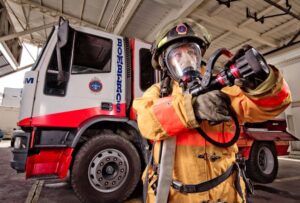Introduction to Fire Safety Training.
Picture this: You arrive at work, ready to face the day ahead. What if calamity hits in the shape of a fire? Are you prepared to deal with such an emergency? Fire safety training is more than just a checkbox; it’s an essential component of workplace safety that can save lives and safeguard businesses. Let’s look at why fire safety training is vital in every company.
Importance of Fire Safety at Work
Fire safety in the workplace is a significant issue that must not be disregarded. Proper fire safety precautions can help to prevent disasters and save lives. Employees are better prepared to respond to emergencies if they receive proper training.
A thorough fire safety strategy protects personnel, precious assets, and business continuity. In the event of a fire, being prepared might be the difference between minor damage and catastrophic loss.
Regular fire drills and training sessions assist employees become acquainted with evacuation protocols and how to use firefighting equipment effectively. This hands-on training boosts confidence and ensures a quick response while dealing with real-life problems.
Investing in fire safety training displays a commitment to putting employee well-being first and creating a safe working environment for everybody. Remember, when it comes to fire safety, prevention is essential!

Key Aspects of Fire Safety Training:
Understanding the fundamentals: Fire safety training covers topics such as fire dangers, prevention, and emergency response protocols. Employees learn about many sorts of fires and proper firefighting procedures.
Emergency evacuation drills: Practising evacuation drills is critical to ensuring that everyone learns how to properly escape the building in the event of a fire. This hands-on experience helps personnel become familiar with evacuation routes and assembly spots.
Employees are instructed on how to use fire extinguishers, alarms, sprinkler systems, and other firefighting equipment properly. Understanding how to use these instruments can make a big difference in an emergency.
Risk assessment techniques: Identifying potential fire dangers in the workplace is critical to avoiding accidents. Training covers risk evaluation methodologies as well as risk mitigation approaches.
Communication protocols: Clear communication is essential during a fire emergency. Employees are educated how to sound the alarm, call the authorities, and offer correct information about the issue.

Employee Responsibilities during Fire Safety Training
When it comes to workplace fire safety training, employees play an important part in protecting their own and their colleagues’ safety. Understanding their responsibilities can help them prevent and manage fires more effectively.
Employees should become familiar with the placement of fire exits, extinguishers, alarms, and emergency assembly sites on the premises. It is critical to understand how to properly use firefighting equipment and safely evacuate during an emergency.
Proactively reporting potential fire dangers, such as faulty wiring or blocked exits, can help avoid incidents before they happen. Employees that actively participate in regular fire drills and training sessions will be more prepared for emergencies.
Taking responsibility for one’s own safety and being careful about following established safety standards can considerably lower the chance of injuries or fatalities in the event of a fire catastrophe.
Resources for Fire Safety Training.
There are several options available to guarantee that employees receive sufficient fire safety training in the workplace. Organisations might benefit from online courses, workshops, and seminars led by certified professionals. In addition, fire safety instructions, movies, and simulations can help personnel improve their knowledge and skills in dealing with emergency scenarios.
Businesses who invest time and effort in fire safety training not only comply with rules, but also provide a safer working environment for their staff. Remember that prevention is always preferable to coping with the aftermath of a calamity. Stay educated and prepared!
